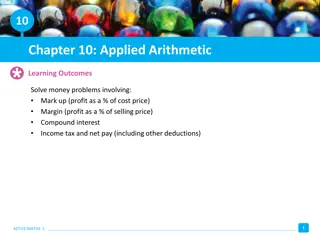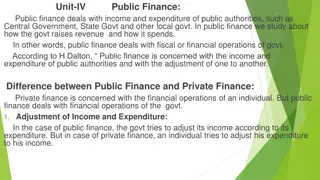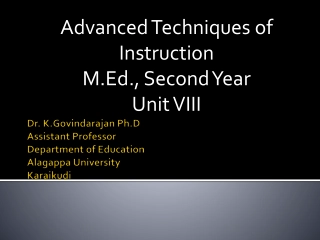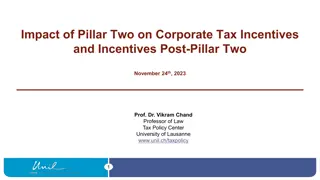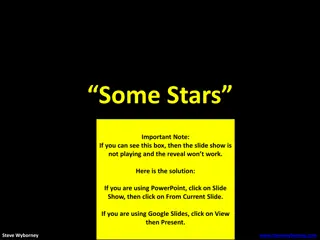Understanding Deductions in Personal Finance
In Lesson 2 of "Deductions: What You See Is Not What You Get," the content delves into concepts central to financial literacy. Covering topics like gross and net income, types of deductions, compound interest for retirement planning, and the workings of insurance (including health insurance), this lesson aims to equip individuals with essential knowledge to manage their finances effectively. The lesson stresses the significance of understanding how deductions impact one's income and financial well-being.
Download Presentation

Please find below an Image/Link to download the presentation.
The content on the website is provided AS IS for your information and personal use only. It may not be sold, licensed, or shared on other websites without obtaining consent from the author. Download presentation by click this link. If you encounter any issues during the download, it is possible that the publisher has removed the file from their server.
E N D
Presentation Transcript
Deductions What You See Is Not What You Get Lesson 2
RMRW Lesson 2: Deductions What You See Is Not What You Get Objectives Define gross and net income Understand the types and purpose of deductions taken out of gross income Understand compound interest and why to save early for retirement Understand how insurance works and basic health insurance Calculate net income for simulation
RMRW Lesson 2: Deductions What You See Is Not What You Get Gross Income If you make $10 per hour and work 40 hours per week your gross income is $400/week But, will you receive all $400 to use and spend? No . . .
RMRW Lesson 2: Deductions What You See Is Not What You Get Net Income Gross Income Deductions = Net Income
RMRW Lesson 2: Deductions What You See Is Not What You Get Types of Deductions Other Deductions Health insurance (medical, dental, vision) Retirement Life insurance Disability insurance Primary Taxes Federal income tax State tax Social Security (FICA) tax Medicare tax
RMRW Lesson 2: Deductions What You See Is Not What You Get Taxes (Withholdings) Federal Tax income tax paid to the U.S. Treasury through the Internal Revenue Service (IRS) State and Local Tax in addition to the state, some cities and school districts may have taxes withheld from pay Federal Insurance Contributions Act (FICA) includes Social Security Tax and Medicare
RMRW Lesson 2: Deductions What You See Is Not What You Get Insurance what is it and how does it work? Insurance is a way to reduce the financial risk you face in case that something bad happens like getting sick or getting in a car accident. Imagine you get in a car crash. If you have insurance, your insurance company will pay for most of your car repair. You will only have to pay a deductible. A deductible is the amount of money you have to pay before your insurance kicks in and pays the rest of the costs. In order to have access to insurance, you must pay a monthly subscription fee called a premium. This allows you to participate in the insurance plan.
RMRW Lesson 2: Deductions What You See Is Not What You Get Health Insurance You can choose whether you want to purchase a high or low deductible insurance. Low deductible insurance has a higher monthly premium than high deductible insurance. Plan Type Monthly Premium Deductible Low deductible $300 $500 High deductible $150 $2,000
RMRW Lesson 2: Deductions What You See Is Not What You Get Health Insurance Example Imagine you fall and break your arm and your hospital bill is $1,500. Here will be your costs if you chose the low versus high deductible insurance plan. Plan Type Monthly Premium Deductible Out-of-pocket costs Low deductible $300 $500 High deductible $150 $2,000
RMRW Lesson 2: Deductions What You See Is Not What You Get Health Insurance Example Imagine you fall and break your arm and your hospital bill is $1,500. Here will be your costs if you chose the low versus high deductible insurance plan. Plan Type Monthly Premium $300 Deductible Out-of-pocket costs $500 (insurance pays $1,000) $1,500 (insurance pays $0) Low deductible $500 High deductible $150 $2,000
RMRW Lesson 2: Deductions What You See Is Not What You Get Retirement savings Retirement Savings Strive for 2% 6% of gross income Some employers match a portion
RMRW Lesson 2: Deductions What You See Is Not What You Get Savings pays: Interest When you save or invest money with a financial institution, your money will grow without you having to do anything! There are many ways to save your invest: Interest bearing checking and savings accounts, stocks, IRA s, etc. The money you earn from saving your money in any of these is called interest. To maximize the interest, be sure to compare rates offered by different financial institutions and look for the highest rate.
RMRW Lesson 2: Deductions What You See Is Not What You Get Retirement savings: Compound interest It pays to start saving early. Samira and Casey both save $10,000 saving $1,000 a year for 10 years. Samira saves her money early she starts at 16, and has saved $10,000 by 26. Casey doesn t start until age 41 by age 51 he has saved $10,000. Do you think Samira has more, less or the same amount of money as Casey at age 51?
RMRW Lesson 2: Deductions What You See Is Not What You Get Retirement savings: Compound interest $50,000 Samira's savings $40,000 Casey's savings If Samira and Casey both save their money in places where they earn 5% interest per year, then Samira has much more than Casey at age 51 nearly $30,000 more! $30,000 $20,000 $10,000 This is because of compound interest Samira earns money on her savings, as well as on all the extra interest money for many years. $0 16 18 20 22 24 26 28 30 32 34 36 38 40 42 44 46 48 50 Age
RMRW Lesson 2: Deductions What You See Is Not What You Get Other deductions Other Deductions (not calculated for simulation) Child Support Liens Debt Repayment Court Costs
Calculating Deductions Federal Tax Example: If your gross monthly income is $3,700, the Federal Tax would be $311 monthly. Monthly Payroll Period Monthly Salary 1350 to 1679 1680 to 2009 2010 to 2339 2340 to 2669 2670 to 2999 3000 to 3329 3330 to 3659 3660 to 3989 Quick Code Married $55.15 $88.15 $121.15 $154.15 $192.84 $232.44 $272.04 $311.64 A B C D E F G H
RMRW Lesson 2: Deductions What You See Is Not What You Get Determining Simulation Net Income Calculate Deductions Example Description DEDUCTION (subtract from balance) DEPOSIT (add to balance) BALANCE $2,936 Gross Monthly Income $325 $2,611 Federal Tax Subtracted $ State and Local Tax (5.5% x Gross Income= Deduction) $ FICA (Social Security / Medicare) (7.65% x Gross Income= Deduction) $ Retirement Savings (at least 5% x Gross Income= Deduction) $ Monthly Net Pay (Monthly Gross Pay Deductions = Net Pay)
Calculating Deductions State & Local Taxes estimate 5.5% of gross pay If your gross monthly income is $3,700, the math would be: .055 x $3,700 = $283.05 So on your calculator: .055 x $GROSS = $Deduction
RMRW Lesson 2: Deductions What You See Is Not What You Get Determining Simulation Net Income Calculate Deductions Example Description DEDUCTION (subtract from balance) DEPOSIT (add to balance) BALANCE $ 2,936 Gross Monthly Income $325 $ 2,611 Federal Tax Subtracted $292 $ 2,319 State and Local Tax (5.5% x Gross Income= Deduction) Subtracted $ FICA (Social Security / Medicare) (7.65% x Gross Income= Deduction) $ Retirement Savings (at least 5% x Gross Income= Deduction) $ Monthly Net Pay (Monthly Gross Pay Deductions = Net Pay)
Calculating Deductions FICA is 7.65% If your gross monthly income is $3,700, the math would be: .0765 x $3,700 = $283.05 So on your calculator: .0765 x $GROSS = $Deduction
RMRW Lesson 2: Deductions What You See Is Not What You Get Determining Simulation Net Income Calculate Deductions Example Description DEDUCTION (subtract from balance) DEPOSIT (add to balance) BALANCE $ 2,936 Gross Monthly Income $ 325 $ 2,611 Federal Tax Subtracted $ 292 $ 2,319 State and Local Tax (5.5% x Gross Income= Deduction) Subtracted $ 298 $ 2,021 FICA (Social Security / Medicare) (7.65% x Gross Income= Deduction) Subtracted $ Retirement Savings (at least 5% x Gross Income= Deduction) $ Monthly Net Pay (Monthly Gross Pay Deductions = Net Pay)
Calculating Deductions Retirement Savings is recommended 5-7% If your gross monthly income is $3,700, the math would be: .05 x $3,700 = $185.00 .07 x $3,700 = $283.05 So on your calculator: % you choose to save x $GROSS = $Deduction
RMRW Lesson 2: Deductions What You See Is Not What You Get Determining Simulation Net Income Calculate Deductions Example Description DEDUCTION (subtract from balance) DEPOSIT (add to balance) BALANCE $ 2,936 Gross Monthly Income $ 325 $ 2,611 Federal Tax Subtracted $ 292 $ 2,319 State and Local Tax (5.5% x Gross Income= Deduction) Subtracted $ 298 $ 2,021 FICA (Social Security / Medicare) (7.65% x Gross Income= Deduction) Subtracted $ 274(used 5%) $ 1,747 Retirement Savings (at least 5% x Gross Income= Deduction) Subtracted $ 1,747 Monthly Net Pay (Monthly Gross Pay Deductions = Net Pay) This is your MONTHLY NET PAY Subtracted
RMRW Lesson 2: Deductions What You See Is Not What You Get Determine Family Size for the Simulation Children Number and ages are randomly assigned







